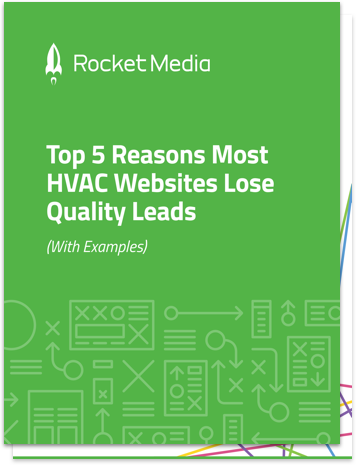Local SEO for HVAC Companies: A Beginner’s Guide
on July 31, 2017
It’s no longer up for debate: To be found online, your HVAC company needs a solid SEO strategy.
Unfortunately, SEO is complicated. And most SEO guides out there are useless because they:
- Use too much jargon
- Aren’t relevant to the HVAC industry
So, we’re changing that.
In this article, we’ve written a simple, easy-to-understand guide that shows you exactly where your HVAC company needs to focus your SEO efforts—and why.
Specifically, we’ll cover:
- Google Maps rankings vs. Google Search rankings
- Why you need to rank well in both Maps and Search
- How to improve your Maps and Search rankings
Ranking twice: Google Maps rankings vs. Google Search rankings
Because your HVAC company is a local business, you actually need to rank well on two separate places within Google:
- Google Search (where all companies try to rank)
- Google Maps (where local businesses also need to try to rank)
Now here’s the bottom line: If you don’t rank for both, your company is only visible to a fraction of your target audience. Put another way, if you rank in both Search and Maps, you essentially rank twice for the same keywords.
Let us show you what we mean:
When we type the keyword “AC repair in Phoenix” in Google, the results look like this:
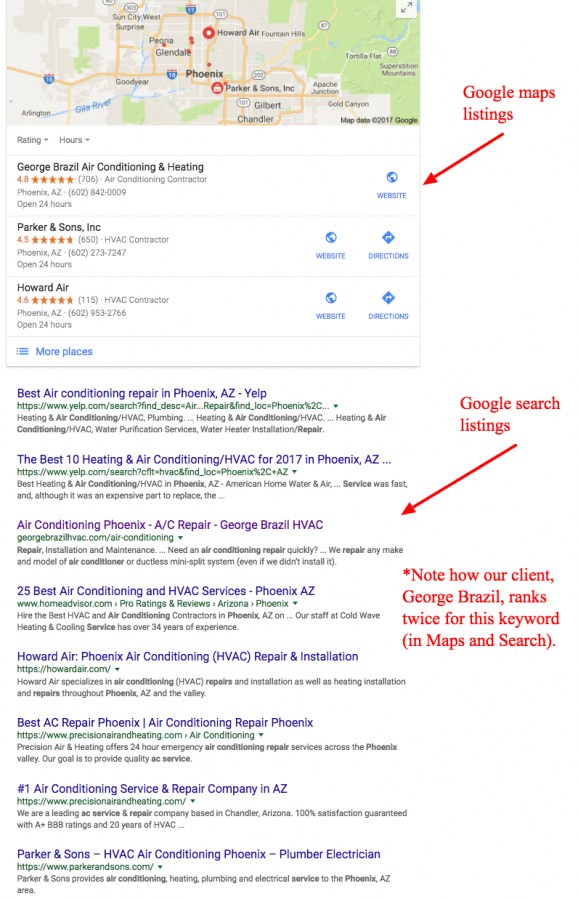
George Brazil essentially “ranks twice” for the same keyword phrase. This gives them “increased real estate” on a Google results page. In other words, ranking in both Maps and Search for the same keyword gives customers twoplaces to click through to your website and information.
But why does Google deliver two different kinds of results? Because they’re targeting different types of customers (see below).
Google Maps listings
- Also called: “Local listings”, “Local pack listings”, “Local SERPS” or “Local 3-pack”
- Who it targets: Local, nearby customers who are closer to making a purchasing decision.
- What it shows: A “quick look” at nearby companies (contact info, hours of operation, reviews and photos, a link to the company’s website, etc.)
Google Search results
- Also called: “Organic listings” or “Traditional listings”
- Who it targets: Customers who need to learn more information related to their question or phrase. Customers may be nearby OR they could live farther away in outlying cities.
- What it shows: Pages that have quality content and are associated with popular websites.
The key difference? Local intent. When people include phrases like “in Phoenix” in their queries, Google wants to make sure it brings up close local businesses. Hopefully, yours.
Why you need to rank well in both Maps and Search
Focusing on ranking in both Maps and Search for HVAC-related keywords helps you reach a much wider audience by:
- Increasing your website’s ranking “real estate” on a single Google results page
- Targeting customers who live in nearby and outlying cities
- Targeting customers who are ready to purchase HVAC services and customers who aren’t yet ready to purchase (but will be later on down the road)
Note: Targeting homeowners who aren’t yet ready to purchase HVAC services is NOT a waste of time. If you provide them with reliable, trustworthy information, they’re more likely to remember your company when they do need HVAC services.
Think of it this way: ranking in Google Maps helps you win customers who are closest to you but ranking in Google Search can help you win those farther away.
Here’s an example:
In the screenshot below, you’ll see that our client isn’t ranking in Google Maps for the keyword “AC Repair in Peoria, AZ”, but they are ranking in Google Search.
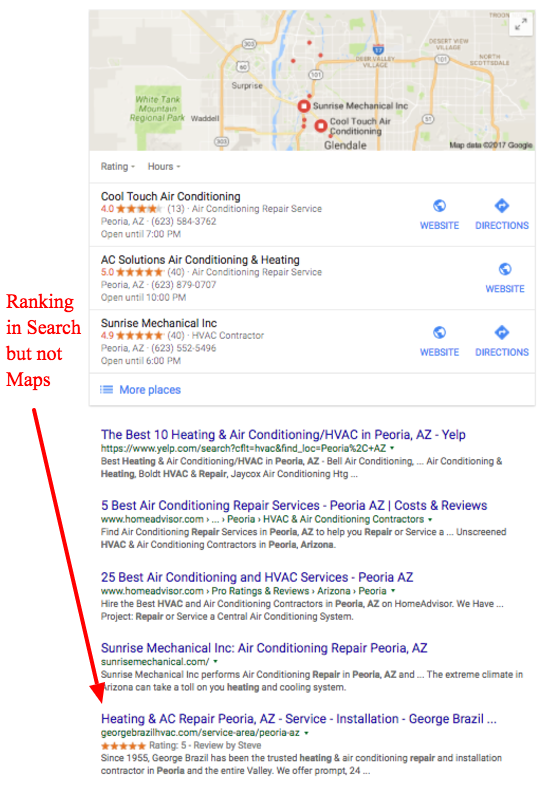
So why is this such a victory for George Brazil?
Because Peoria, AZ is over 20 miles from George Brazil’s storefront address. And that 20-mile distance makes it very hard for George Brazil to rank in Maps when Peoria homeowners search for local HVAC services. Remember, Google Maps favors companies that are close to the searcher.
But because Google Search prizes quality content over location, we knew that we could target Peoria homeowners by creating content based around the keyword “Heating & Air Conditioning Repair Peoria, AZ”.
Now that we’ve shown you why it’s important to rank in both Maps and Search, let’s look at how you can increase your Google Maps and Search rankings.
How to increase your Google Maps rankings
- Be aware that “proximity to the searcher” matters
- Optimize your Google My Business listing
- Get cited on other local listing sites
Note: The factors above are just the top 3 Map ranking factors. Check out this article for a complete list of Google Map ranking factors..
1. Be aware that “proximity” matters
As we’ve already discussed, proximity to the searcher is the #1 ranking factor for your Google Maps listing.
Bottom line here? You have no control over this factor. The farther away the customer is from your store’s address, the more unlikely it is that you’ll pop up in their Google Maps results when they’re searching for HVAC services.
So why is this knowledge useful if it’s beyond your control? Because knowing that proximity is the biggest factor helps you focus your marketing efforts in the right direction.
Example? You have a city that’s within your company’s service area— but it’s 10 miles from your storefront address. And that’s likely too far for you to pop up in Maps when homeowners in that city search for HVAC services. So you focus on targeting the homeowners in that city via organic search rankings NOT map rankings.
But what should you do to make sure that you’ll pop up in Google Maps for homeowners who are near you? Focus on optimizing your Google My Business listing and getting cited in other local listing sites.
Let’s take a closer look at those 2 factors.
2. Optimize your Google My Business listing
First off, be sure that you claim your company’s Google My Business listing.
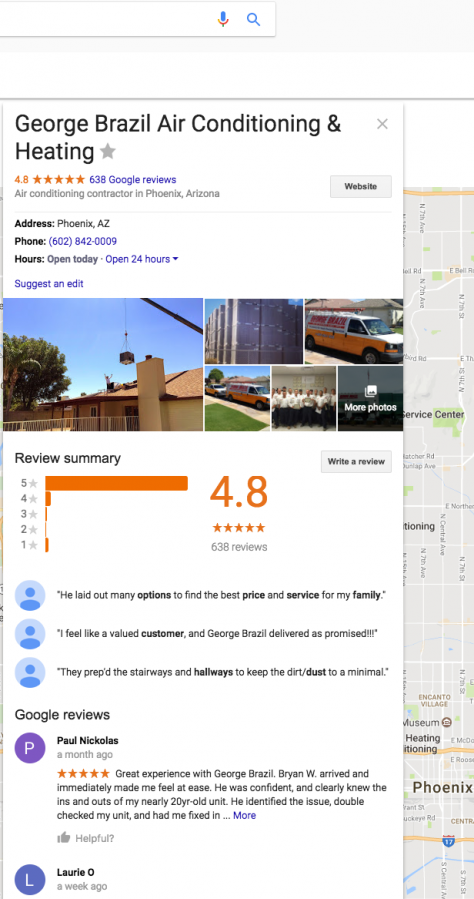
What an HVAC company’s Google My Business listing looks like
If you haven’t yet claimed your company’s Google My Business listing, follow these instructions on how to claim your listing.
Once you have ownership of your listing, focus on optimizing that listing to show Google that you’re worthy of a 3-pack position.
How to optimize your Google My Business listing:
1. Ensure your “NAP” is 100% consistent. Check your NAP (Name, Address, Phone number). Is everything listed and spelled correctly? Make sure the exact spelling of your address (Example: “Rd”. vs “Road” or “Ave”. vs “Avenue”) is consistent with how your NAP is displayed on your website and other local listing sites. This prevents Google from thinking a listing with a slight variation in spelling is actually a completely different company.
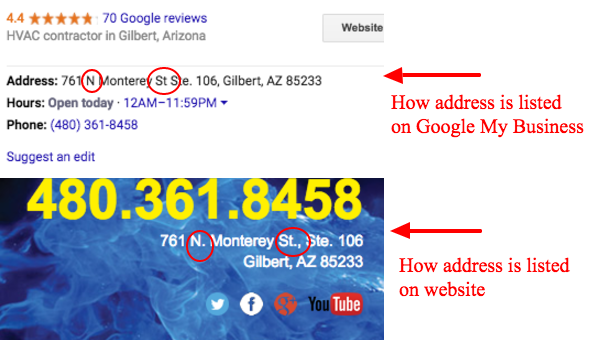
Slight differences between this company’s Google My Business Listing and website can negatively impact their Maps rankings.
2. Fill out all the information on your listing. Does your listing display your hours of operation? Have you uploaded photos that help market your company to customers?
3. Choose a correct (but specific) “category”. Google My Business allows you to choose a primary category to describe your services. Be specific when choosing your primary category. For example, instead of “Contractor” choose “HVAC contractor” or even “AC contractor” or “Heating contractor”.

While Google My Business allows you to showcase several categories, keep in mind that Google suggests using “as few categories as possible to describe your overall core business.” So don’t go overboard here.
4. Find and remove duplicate listings. Yes, it’s possible that another Google My Business listing was created for your company without your knowledge (this can be done by scammy marketing companies or even by customers themselves).
To see if your company has any duplicate listings, just type in “company name + Google My Business”. If you find more than one listing under your company’s name, follow these instructions to remove duplicate listings.
5. Be proactive with reviews. Ask loyal, satisfied customers to post a review about your company. You should also monitor the reviews that come in and always reply (in a professional, sincere manner) to any negative reviews that may come in.
3. Get cited on other local listing sites
A citation is basically an online reference to your business’ NAP. And the more citations your business has, the more likely you are to show up in Google Maps when nearby customers search for you.
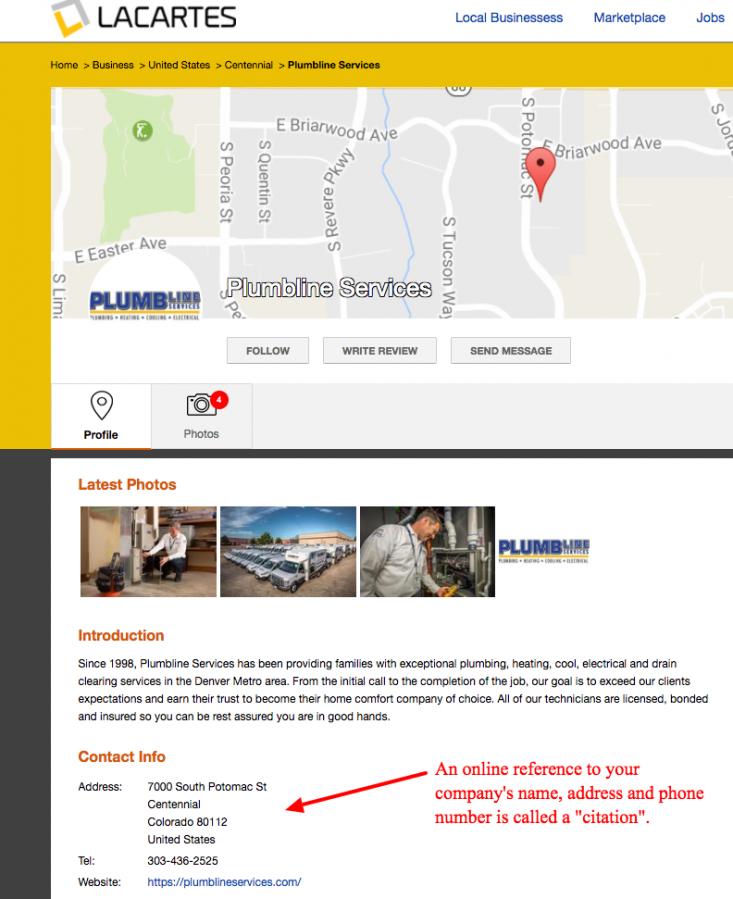
Example of a citation we built for one of our clients on Lacartes, a website that provides local service directories to consumers.
A good starting point for building citations is to create and optimize listings for your HVAC company on sites such as:
- Yelp
- Yellowpages
- Foursquare
- Homeadvisor
But of course, don’t stop there. The more citations you have, the more likely you are to make it to the top 3 Google Maps listings. In fact, we recommend building at least 2-3 new quality citations per month. But above all, to make sure your business’ NAP is consistent across all of the local listing sites!
How to increase your Google Search rankings
1. Create rank-worthy website copy
Even if you have the prettiest website out there, you won’t show up in Google Search results if you don’t have quality content that’s written specifically for your customers.
Tips for rank-worthy website content:
Get rid of duplicate content
Google favors unique content. Never reuse content—whether it’s content from someone else’s site or content from another page on your site (i.e. using the same content on your AC installation page as a heat pump installation page).
Create dedicated service pages
Create pages that are specifically dedicated to your most popular services (if not all of your services).
In other words, if you offer AC repair, maintenance and installation, you should create 3 separate pages for:
- AC installation
- AC repair
- AC maintenance
Why? Well, stuffing 3 different services onto one page makes it more difficult for Google to pinpoint what the page is really about. And think about it, are any of your customers really typing in “AC repair, installation and maintenance” when they need your services?
If a customer has a broken air conditioner, they’re going to type in “AC repair in (city)”. And if your competitor has a page specifically dedicated to AC repair, Google will most likely rank that page higher than your catch-all page.
Real life examples of dedicated vs non-dedicated pages:
Create website content that answers your customers’ questions
Choosing an HVAC company is a big decision for homeowners. And your potential customers have a lot of questions that they need answered before they choose your company.
The more your website’s content focuses on answering these big questions, the more at ease customers will feel about choosing your company, meaning the more qualified leads you’ll see.
Check out how we answered customers’ questions on our client’s website:
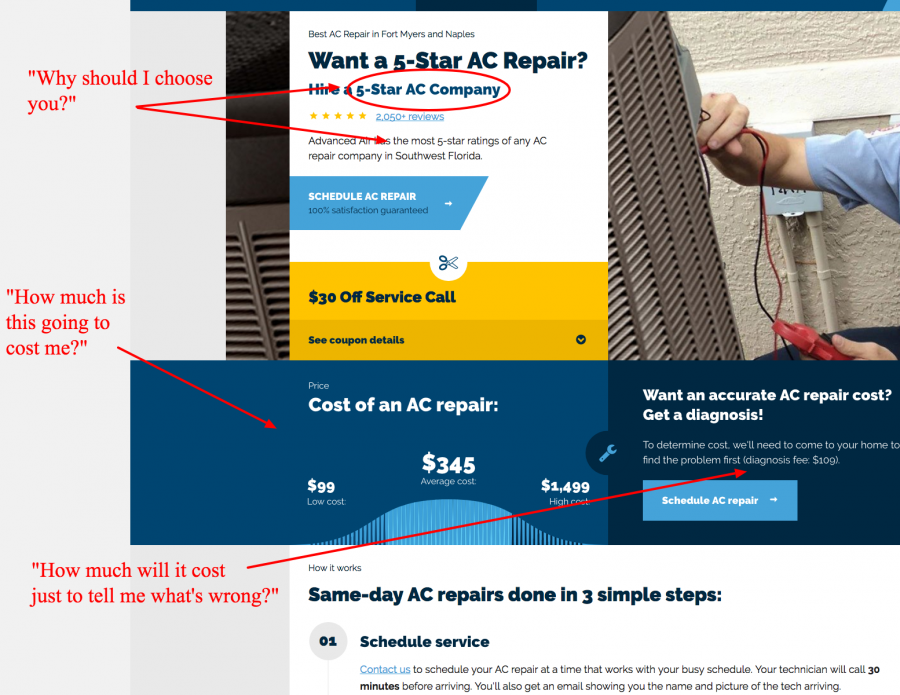
Not sure what questions your customers have? Check out our blog, “5 Questions the Best HVAC Websites Answer”.
Use blogs to target “long-tail” keywords
Long-tail keywords are those longer phrases that are super specific to your particular HVAC services. If your website has a blog (it should), this is the best place to target long-tail keywords.
Blogs that target long-tail keywords drive more traffic to your site (which helps your site’s overall Search rankings).
Some of the best long-tail keywords come in the form of:
- Troubleshooting topics (Example: Why Is My Air Conditioner Making a Whistling Noise?
- FAQs (Example: Should I Close My AC Vents in Unused Rooms?)
- Buyer’s Guides (Example: Single-Stage vs Two-Stage Air Conditioners)
So how do you come up with these long-tail keywords? By determining what phrases/questions people are typing into Google.
Tools such as Google Analytics or SEMrush can help you find commonly searched keywords in your area. But if you don’t have access to these tools, take a look at the questions your customers are asking via your “Contact Us” form or ask techs for common questions they get from homeowners.
Once you find a list of long-tail keywords that are popular in your area, don’t forget to incorporate a “local angle” around that topic/question.
Examples of how we’ve localized long-tail keywords for our clients include:
- “What’s the Cost of a New Central Air Conditioner in Arizona?”
- “Can Florida’s Hard Water Damage My Skin?”
- “Tank vs Tankless Water Heaters: What’s the Best Choice for My Minneapolis Home?
2. Get as many quality backlinks as possible
A backlink is basically any incoming link to a webpage. So, for example, if your HVAC company hosts a fundraiser and the local news channel hears about it, they might write an article about the event. And if they link to your website in the article then voila! You have a backlink.
Here’s another example of a backlink for an HVAC company:
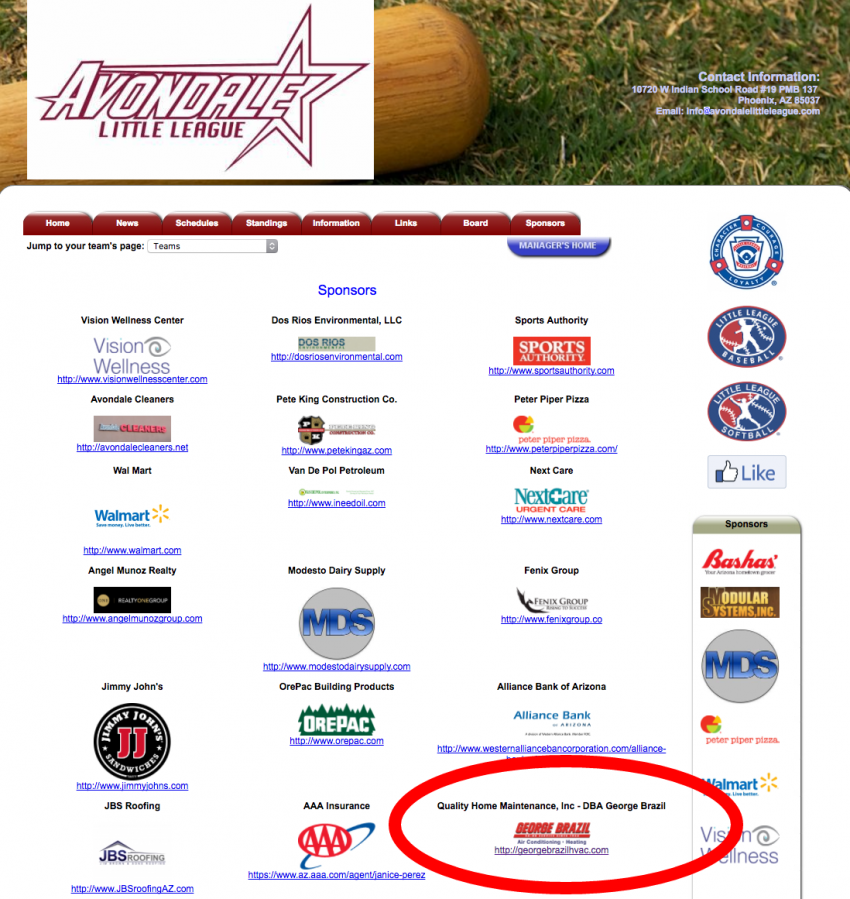
In this example, our client sponsors a local little league organization which earned them a backlink on the organization’s sponsor page.
So why are backlinks so important? Well, they show Google that your site is popular, trusted and authoritative.
But not all backlinks are good for HVAC SEO. Backlinks to your HVAC website should come from sites that are:
- Trusted
- Using best SEO practices we’ve already discussed
- Listing other local businesses
- Relevant to your industry if possible (links from HVAC-related industry are ideal but sites don’t have to be HVAC-related to be a good backlink.)
Now comes the tough part: Actually getting backlinks.
To start off, we suggest getting backlinks from:
- The Better Business Bureau
- Your Chamber of Commerce
But don’t stop there. The more backlinks your HVAC company has, the more trusted it appears to Google, resulting in higher Search rankings. So get creative and start thinking of other local websites that might be willing to provide a backlink.
Ideas that can result in a backlink from local news publications include:
- Hosting an event
- Sponsoring a local high school sports team
- Offering a scholarship
Need help from an experienced HVAC marketing company?
Need help implementing a solid HVAC SEO strategy for your business?
Just contact us at Rocket Media. For over 14 years we’ve specialized in HVAC marketing and have the SEO expertise you need to grow your company.

